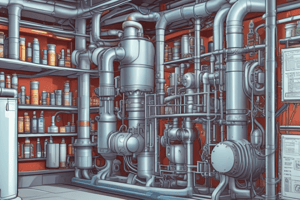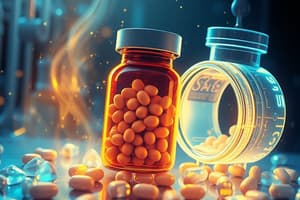Podcast
Questions and Answers
What is the primary purpose of applying a film coating to tablets?
What is the primary purpose of applying a film coating to tablets?
- To form a thin, uniform layer with specific release properties or protection. (correct)
- To enhance the tablet's color and aesthetic appeal.
- To increase the tablet's weight and size.
- To make the tablet easier to break.
Which of the following is an example of a non-enteric coating polymer?
Which of the following is an example of a non-enteric coating polymer?
- Cellulose acetate phthalate
- HPMC phthalate
- Hydroxypropyl methylcellulose (HPMC) (correct)
- Acrylate polymers
What is a primary disadvantage of using organic solvents in film coating?
What is a primary disadvantage of using organic solvents in film coating?
- They can be flammable and toxic and can cause environmental issues. (correct)
- They are cost-effective and environmentally friendly.
- They are highly stable and inert in any environment.
- They are easy to dispose of and do not require special handling.
Why has there been a shift towards aqueous-based coatings in the pharmaceutical industry?
Why has there been a shift towards aqueous-based coatings in the pharmaceutical industry?
What is the typical method for drying a coated tablet in a liquid coating process?
What is the typical method for drying a coated tablet in a liquid coating process?
Which characteristic is NOT desirable for an ideal film coating material?
Which characteristic is NOT desirable for an ideal film coating material?
The choice of polymer for film coating mainly depends on:
The choice of polymer for film coating mainly depends on:
What is typically used to dissolve or disperse polymers when performing liquid coating?
What is typically used to dissolve or disperse polymers when performing liquid coating?
What is the primary purpose of the metering stage in tablet compression?
What is the primary purpose of the metering stage in tablet compression?
Which of the following is NOT a factor in the bonding of particles during tablet compression?
Which of the following is NOT a factor in the bonding of particles during tablet compression?
What role do the feed paddles play in the tablet compression process?
What role do the feed paddles play in the tablet compression process?
During compression, what is expelled from the powder before the particles are bonded?
During compression, what is expelled from the powder before the particles are bonded?
What controls tablet thickness and hardness during the compression stage?
What controls tablet thickness and hardness during the compression stage?
Which stage involves the use of a take-off blade?
Which stage involves the use of a take-off blade?
What is the function of the lower punch during the ejection phase?
What is the function of the lower punch during the ejection phase?
What is a main benefit of using tablets as a dosage form?
What is a main benefit of using tablets as a dosage form?
What is the primary reason for monitoring tablets regularly after production?
What is the primary reason for monitoring tablets regularly after production?
Which of the following is NOT a primary objective of tablet coating?
Which of the following is NOT a primary objective of tablet coating?
What is the primary purpose of applying a sealing coat to a tablet core?
What is the primary purpose of applying a sealing coat to a tablet core?
Which materials are typically used for sealing tablet cores?
Which materials are typically used for sealing tablet cores?
During the coating process, how is the liquid portion of the coating solution typically removed?
During the coating process, how is the liquid portion of the coating solution typically removed?
What is a key characteristic of tablets that are suitable for sugar coating?
What is a key characteristic of tablets that are suitable for sugar coating?
What is the main objective of the sub-coating process of tablet sugar coating?
What is the main objective of the sub-coating process of tablet sugar coating?
Why is talc often added during the sub-coating stage?
Why is talc often added during the sub-coating stage?
What is the main reason for applying an acid-resistant enteric coating to tablets?
What is the main reason for applying an acid-resistant enteric coating to tablets?
What is the purpose of smoothing subcoated tablets before coloring?
What is the purpose of smoothing subcoated tablets before coloring?
Which of the following is NOT a common method used for tablet coating?
Which of the following is NOT a common method used for tablet coating?
What is the purpose of adding a polishing step after color coating?
What is the purpose of adding a polishing step after color coating?
What is the most modern and common approach to tablet coating today?
What is the most modern and common approach to tablet coating today?
Which method is used for printing product information onto sugar-coated tablets?
Which method is used for printing product information onto sugar-coated tablets?
What kind of defect is most likely to be caused by an error in the granulation process?
What kind of defect is most likely to be caused by an error in the granulation process?
What is the primary reason film coating has replaced sugar coating in modern pharmaceutical production?
What is the primary reason film coating has replaced sugar coating in modern pharmaceutical production?
Flashcards
Tablet
Tablet
A solid dosage form made by compressing powdered medication.
Filling (Tablet Compression)
Filling (Tablet Compression)
The transfer of powdered medication into the tablet compression machine.
Metering (Tablet Compression)
Metering (Tablet Compression)
The process of ensuring a consistent amount of powder is fed into the tablet die.
Compression (Tablet Compression)
Compression (Tablet Compression)
Signup and view all the flashcards
Ejection (Tablet Compression)
Ejection (Tablet Compression)
Signup and view all the flashcards
Bonding Mechanisms (Tablet Compression)
Bonding Mechanisms (Tablet Compression)
Signup and view all the flashcards
Advantages of Tablets
Advantages of Tablets
Signup and view all the flashcards
Excipients (Tablet Compression)
Excipients (Tablet Compression)
Signup and view all the flashcards
Tablet Defects
Tablet Defects
Signup and view all the flashcards
Tablet Coating
Tablet Coating
Signup and view all the flashcards
Objectives of Tablet Coating
Objectives of Tablet Coating
Signup and view all the flashcards
Sugar Coating
Sugar Coating
Signup and view all the flashcards
Film Coating
Film Coating
Signup and view all the flashcards
Press Coating
Press Coating
Signup and view all the flashcards
Enteric Coating
Enteric Coating
Signup and view all the flashcards
Coating Process
Coating Process
Signup and view all the flashcards
What is sealing tablet core?
What is sealing tablet core?
Signup and view all the flashcards
Why do we need to seal tablet core?
Why do we need to seal tablet core?
Signup and view all the flashcards
How is sealing tablet core done?
How is sealing tablet core done?
Signup and view all the flashcards
What is Sub-coating?
What is Sub-coating?
Signup and view all the flashcards
What is smoothing?
What is smoothing?
Signup and view all the flashcards
What is the coloring step?
What is the coloring step?
Signup and view all the flashcards
What is polishing?
What is polishing?
Signup and view all the flashcards
What is printing?
What is printing?
Signup and view all the flashcards
Non-enteric Coating Polymers
Non-enteric Coating Polymers
Signup and view all the flashcards
Enteric Coating Polymers
Enteric Coating Polymers
Signup and view all the flashcards
Coating Solvent
Coating Solvent
Signup and view all the flashcards
Liquid Coating Technology
Liquid Coating Technology
Signup and view all the flashcards
Organic Film Coating
Organic Film Coating
Signup and view all the flashcards
Aqueous Film Coating
Aqueous Film Coating
Signup and view all the flashcards
Conversion From Organic to Aqueous Film Coating
Conversion From Organic to Aqueous Film Coating
Signup and view all the flashcards
Study Notes
Tablet Compression
- A tablet is a solid pharmaceutical dosage form made from compressed powder.
- Types include sublingual, chewable, effervescent, film-coated, and enteric-coated tablets.
- Tablet compression involves four stages: filling, metering, compression, and ejection.
Filling
- Raw materials are transferred into the tablet compression machine's hopper, either manually or automatically.
- Powder flows from the hopper into the compression chamber.
Metering
- Excess powder is removed from the machine.
- The feeder system ensures consistent and accurate powder measurements into the die.
- The lower punch's adjustable height controls the exact weight of the compressed powder.
Compression
- Upper and lower punches compress the powder within a die under pressure.
- Air is expelled from between the granules before compression begins.
- The thickness and hardness of the tablet are controlled by adjusting the height of the punches.
- Particles bond through mechanical interlocking (entanglement), phase transitions, and intermolecular forces (van der Waals, hydrogen bonding, ionic bonding).
Ejection
- Tablets are removed from the lower punch-die station.
- The upper punch retracts, while the lower punch pushes the tablet upward onto a die table.
- A take-off blade directs tablets through a discharge chute.
- Tablets are usually collected in a container, often after being passed through a deduster and metal detector.
Tablet Coating
- Coating tablets with an edible paint improves the taste, odor, or color of medications.
- Coating also protects the drug, controls its release, protects from stomach acids, incorporates other drugs, or provides sequential drug release.
- Coating methods generally use solutions sprayed onto rotating tablets.
- The liquid portion evaporates in coating pans or fluid beds, forming a coating film.
Types of Tablet Coating
- Sugar coating is a traditional method using multiple coats of waterproofing substances (like shellac) and sugar.
- Film coating is more modern, applying a polymer solution to create a thin film.
- Press coating involves using compression to coat a pre-formed core.
Capsule Manufacturing
- Capsules are solid dosage forms containing medicinal and/or inert materials encased in a gelatin shell
- Gelatin capsules can be hard or soft, depending on the formulation.
- Hard gelatin capsules consist of two parts (cap and body) which fit together
Powder Technology
- A powder is a dry bulk solid consisting of many fine particles.
- Powders are often classified as aerosol, bulk, divided, or effervescent, based on their use or intended use.
Sterilization
- Sterilization effectively kills or eliminates transmissible agents (like bacteria, fungi, viruses) from a surface, equipment, or product.
- Methods include physical methods (e.g., heat, radiation, filtration) and chemical methods (e.g., gaseous, liquid).
Studying That Suits You
Use AI to generate personalized quizzes and flashcards to suit your learning preferences.




